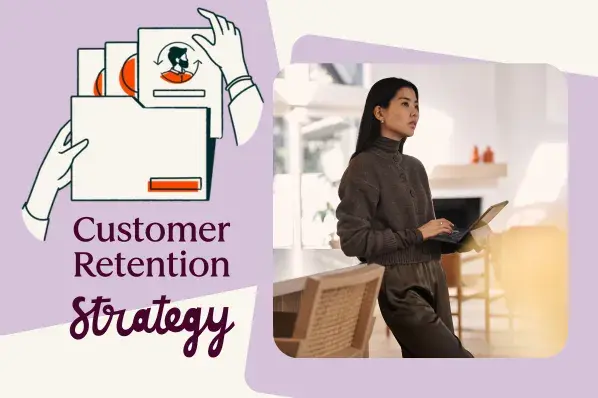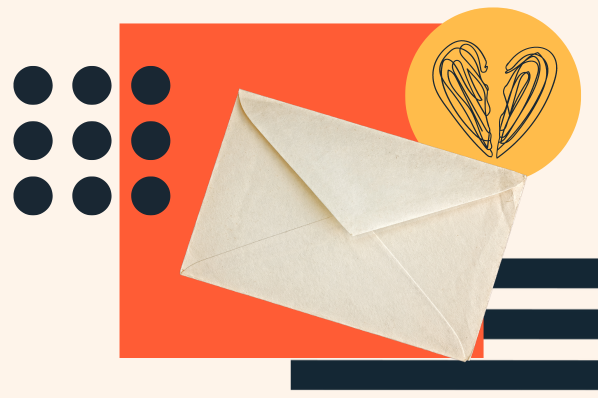And I'm no mind reader, but I'm willing to bet that new demand generation for a business relies on keeping existing customers around.
Let's walk through a few strategies to reduce customer churn at your company.
Table of Contents
- Customer Churn
- Causes of Customer Churn
- Types of Customer Churn
- How to Identify Customer Churn
- How to Reduce Customer Churn
Customer Churn
Customer churn refers to the percentage of customers that ended the use of your company's product or service during a set period of time. It's typically calculated by dividing the number of customers you lost in a specific time period (e.g., the previous quarter) by the number of customers you started that time period with.
Customer churn — also known as customer attrition — refers to the rate at which customers who purchase or subscribe to your product or service end their relationship with you and stop bringing in revenue for your business.
Calculating Customer Churn Rate
Here's an example of how to calculate churn rate. The formula is outlined in the image below.

Let's say you started last quarter with 500 customers and ended the quarter with 475. That means you lost 25 customers.
To find your churn rate for the quarter, divide the number of customers you lost (25) by the number of customers you started with (500). Then, multiply the result by 100.
25 ÷ 500 = 0.05
0.05 x 100 = 5%
Your churn rate for the quarter is 5%.
Why Churn Matters
While some customer churn is inevitable, a high churn rate can affect your bottom line.
The profitability of your business largely depends on your ability to retain existing customers. In fact, industry research says a 5% increase in customer retention can increase profits by 25% to 95%.
This is why it's important to keep an eye on churn and take steps to stop it before it escalates.
In the video below, learn more about why churn matters and how you can strategically approach churn reduction.
The first step to stopping churn is figuring out what the underlying cause is. We'll discuss some common causes next.
Causes of Customer Churn
The reasons why customers churn can be personal and unique to each customer, but they usually fall under a few common categories.
We'll explore each below.
Price
Price is a common objection for salespeople and customer success managers alike.
If customers find a more cost-effective solution to the problem they want to solve, they may churn.
This is why it's important to establish value and customer onboarding and education so customers feel that the purchase is worth the cost.
Product/Market Fit
Poor product or market fit is another common reason for customer churn, and it speaks to the need for close sales and customer service alignment.
If salespeople are hustling to hit quota and aren't incentivized to sell to good-fit customers, the result will be churn within a few months of purchase when the customer realizes they can't achieve their goals using your solution.
User Experience
If the user experience with software or applications is buggy, glitchy, or otherwise difficult for them, they'll be less likely to use it on a regular basis or recommend it to a friend.
Customer Experience
Finally, if a customer's experience connecting with other aspects of your brand — such as your marketing content or customer support team — isn't positive, they may be more likely to churn.
Customers want to feel welcomed and valued by communities they support. If they don't have positive experiences interacting with your company, they won't want to stick around.
While these factors typically cause customer churn, there are few different types of churn you should be aware of as well.
In fact, you might be surprised to find that some churn is actually good for your business.
Types of Customer Churn
Here are seven of the most common types of customer churn across industries.
1. Revenue Churn
Revenue churn is slightly different from customer churn, but it's still important to consider when you're analyzing this metric.
Revenue churn is the amount of revenue that's lost within a given period. This doesn't necessarily mean you're losing customers, but rather you're not making as much money from your customer base as you did before.
This can happen if customers downgrade to a cheaper subscription or version of your product. While they're still shopping at your business, they're spending less money than they did before.
2. Competitor Intervention
Every business has its competitors and there's always going to be some customers that will leave you for another company. It's not ideal, but it happens and you can't spend all of your time worrying about it.
It's more important to focus on why these customers are leaving you for your competition. Are they a bad fit for your business? Or, is it something you're doing that's pushing them away?
Once you can figure out the cause, you'll know which customers you should work to keep, and which ones are going to leave your business anyway.
3. Unsuccessful Onboarding
For some businesses, it's common for customer churn to take place at the beginning of the customer journey.
That's because these companies typically don't offer an onboarding program that teaches the customer how to use the product or service.
That means it's up to the customer to figure out how the product works and how it can meet their needs.
If you're purchasing rice, you'll probably just need a set of directions printed on the side of the box.
But, if you're paying thousands of dollars for software that runs your business, you might expect a bit more in terms of support and resources from your software provider.
Today, 74% of enterprise organizations have a dedicated customer onboarding team. A good customer onboarding program can help you reduce churn.
4. Desired Feature or Functionality
Over half of consumers say they expect all experiences to be personalized.
This craving for personalized experiences means that most of your customer base will expect you to create new features or products that solve their needs.
If you have a diverse customer base, some may be disappointed when you roll out a new product or feature that feels irrelevant to their goals.
While this new product may be great for the majority of your target audience, there may be a lingering segment that feels your brand is going in a different direction than what they expected.
This is a type of customer churn that isn't always a bad thing.
If your brand is in fact going in a new direction, then that may come at the expense of some customer churn. Just be sure to actively monitor your churn rate to ensure it doesn't get too high.
5. Company Closure
If you're a B2B business, then you may have customers that go out of business or merge with another company.
Most of the time, these instances are unavoidable and are part of working in a B2B environment. This is where your customer acquisition strategy becomes important as it balances out your customer churn rate.
6. Underappreciated Brand Values
Similar to a "bad fit" customer, some people may not align with your brand values.
For example, if your company prides itself on providing eco-friendly products, you may come across some people who don't value this manufacturing process.
Instead, these customers are more focused on a lower price point and fast delivery process than they are on buying "green" products.
So, do you give in and conform to these customers? Or, stand strong with your brand values?
Customers power your flywheel, but, just like a car, it's important to put the right fuel into your engine. If you conform too much to the wrong segment of your target audience, your brand will suffer over the long haul.
Instead, lean into feedback from your most loyal customers, as they'll share a vision that aligns with your brand's values.
7. Plateaued Growth
As your company grows, it changes, too. Your customer base gets bigger, you hire more employees, and you can offer more products and services that appeal to a larger audience.
This type of change is great for your business, but it can sometimes come at the expense of customer churn.
For instance, let's say you originally offered a free product that you now realize customers would be willing to pay for if it was packaged with another set of products.
While this change will lead to more revenue, you may end up losing customers who only wanted the free product. Now that they'll have to pay for it, they'll move on to another company that doesn't charge them.
This is another example of natural customer churn. Yes, you're losing customers at first, but you're ultimately replacing them with new ones who will pay more for your product or service.
How to Identify Customer Churn
With churn coming in many shapes and sizes, it can be difficult to recognize what's natural churn, what's negative churn, and what isn't churn at all.
To make sure you're aware of all types happening at your business, read on to learn how you can identify a pattern of customer churn.
Establish customer churn metrics.
The first step to identifying customer churn is determining what churn means for your company.
Depending on your business model, churn may mean the customer cancels a subscription, uninstalls your app, or doesn't return to purchase your product after a certain period of time.
Whatever it is for your business, you'll need a set of metrics to monitor customers that are at risk of leaving your company. That way, you can set clear benchmarks for when you think a customer is about to churn.
Pro tip: You can document and track these metrics with HubSpot's free Customer Service Metrics Calculator, which helps you identify when your churn is getting to an unacceptable rate so your company can course correct.

Gather customer feedback.
Sometimes customers will tell you directly when they're unhappy. In all other instances, it's helpful to give your customers a nudge using customer feedback surveys.
Surveys can help you collect both quantitative and qualitative feedback, so you can easily identify which customers are upset with your business and see why they feel that way.
Pro tip: Send your customers an NPS survey after a customer service case, so customers can provide immediate feedback about their experience with your brand.
Check-in with your customer success team.
Rather than waiting for customers to tell you how they feel, you can dispatch your customer success team to find out for you.
Your CS team should be monitoring individual accounts and reaching out to users who are unhappy with your product or service.
That way, you can immediately clear any roadblocks for customers instead of having them reach out to your support team.
Pro tip: Most customer success teams set up regular check in schedules with their customers. Even if they don't have a problem to solve, these meetings are great ways to gather up-to-date information on how the user is feeling.
Prioritize proactive customer service.
Proactive customer service means your business is actively trying to identify and solve problems before they affect the customer experience.
During this process, it's common to uncover points of friction that you may not have been aware of before.
By correcting these issues, you can see how they influence your churn metrics and whether or not they were a significant cause of customer churn.
Pro tip: Resources like knowledge bases and automated chat features can help you implement proactive customer service without putting all of the pressure on your support team.
Monitor community forums and third-party review sites.
Another set of resources you can leverage are your community forum and third-party review sites.
Community forums are where your customers come together to talk about your products and services. If you notice the same users bashing your products again and again, then you know these people are at a higher risk of churn.
The same goes for third-party reviews. The people who give your company the lowest ratings are the ones who are most likely to leave your business.
Pro tip: If you can, reply to third-party reviews and see if you connect with these customers and solve pending issues before churn happens..
Now that you know what churn looks like, let's talk about what you can do to reduce customer churn rate at your business.
How to Reduce Customer Churn
- Lean into your best customers.
- Be proactive with communication.
- Define a roadmap for your new customers.
- Offer incentives.
- Ask for feedback often.
- Analyze churn when it happens.
- Stay competitive.
- Provide excellent customer service.
- Create a community around your customers.
- Dedicate CSMs to your most valuable customers.
- Focus on attracting the right customers.
- Make it easy for customers to stay long term.
As mentioned above and highlighted in the image below, we've compiled 12 tips to reduce customer churn at your business.

Let's review each in more detail.
1. Lean into your best customers.
For a lot of businesses, solving for churn means identifying a pool of customers that are most likely to cancel, and refocusing your efforts to keep them on board.
However, Sunil Gupta, the Edward W. Carter Professor of Business Administration at Harvard Business School, suggests that this strategy is lacking.
Rather than redirecting time and resources to retaining any customers on the brink of churning, Gupta recommends businesses focus their attention on the most profitable customers on the brink of churning.
"If I offer an incentive to customers most likely to churn, they may not leave the company, but will it be profitable for me?
The traditional method is focused on reducing churn, but we contend the goal should be maximizing profits, rather than only reducing churn."
2. Be proactive with communication.
By reaching out to your customers before they need you, you're demonstrating that you're invested in helping them get the most out of your product or service.
But not any old outreach will do. The type of message or resource you send to them should be directly tied to their product or service usage.
For example, after signing up for SEMrush, I received the following email which encouraged me to check out a whole bunch of features I hadn't explored yet:

By surfacing these features early, SEMrush was able to ensure that I wasn't overlooking the tool's capabilities — helping to keep me both interested and active.
3. Define a roadmap for your new customers.
Getting started with a new product or service can be overwhelming.
And if a customer can't figure out how to navigate your product or service right out of the gate, they'll likely lose interest — fast.
To ease the transition, it's helpful to set up a new customer onboarding process or roadmap to guide new customers through your product or service's features, functionality, and process.
Customers that feel empowered to achieve success with the help of your business are less likely to leave.
So it's important that you're constantly monitoring and iterating on your onboarding process and keeping an eye out for snags or blockers.
Looking for inspiration? Here's the onboarding email I received from Grammarly after signing up:

Notice how the welcome email introduces a bunch of popular features to help warm me up to the tool.
4. Offer incentives.
Give customers a reason to stick around by offering them something special like a promo, discount, or loyalty program.
This small effort can go a long way when it comes to showing your existing customers how much you value their business.
When determining when to surface these incentives, there are a few things to consider.
For one, you'll want to think about the customer's timeline: If they are approaching the end of their contract and you're worried they might not renew, providing a discounted renewal rate could be the push they need to stick around.
Another thing to consider is the customer's needs. Baremetrics used the following strategy after receiving feedback from customers who were ready to cancel due to a lack of features.
"We'd offer a discount on their next month of service to tide them over while we finished up what it was they were looking for," explains Baremetrics' founder Josh Pigford.
The impact? This small effort helped them save 15% of the accounts that were ready to cancel.
5. Ask for feedback often.
Customer frustration, which can ultimately lead to customer churn, surfaces when there is confusion about a product or a lack of support around a particular issue.
But those concepts are vague. And getting to the root of the specific issues plaguing your business requires you to take the time to collect feedback early and often.
Depending on your business needs, creating a customer feedback loop can be as easy as setting up a survey or feedback form and sending an email. Here's a great example from PayPal.

Surveys and rating requests show the customer that you're committed to getting better — and that you're always interested improving.
6. Analyze churn when it happens.
If you're waiting until a customer leaves your business, you're already too late to do anything about it. Instead, you should be using data before customers churn in order to build strategies to proactively prevent it.
No matter how much effort you put into the steps above, churn is a part of any business, and it will happen.
The key is to use your churned customers (and your happy customers) to predict key signs of customer happiness and customer dissatisfaction so you can engage with customers and salvage the relationship before they churn.
First, start with an analysis to figure out when churn typically occurs.
- When are customers most frequently churning?
- Is it 30, 60, or 90 days after they first start using your product or service?
Does churn happen if customers go a specific number of days without using the product or service?Then, get additional customer feedback tofigure out why churn usually occurs.
For example, here's an email that SoulCycle sends when you haven't booked any classes in a while.

SoulCycle most likely determined that a largegap in workout class attendance signaled churn, so they offer a free class to get you back in the door.
7. Stay competitive.
Market conditions are constantly changing. And as new software and technologies enter the space, the needs and demands of your customers will inevitably shift.
Businesses focused on what's next — trends, technology, and product advancements — position themselves in a good spot in terms of avoiding disruption or "the next big thing."
And while keeping your product or service on the cutting edge is important, it's also important that your customer success and support efforts remain relevant.
To ensure your competitors aren't lapping you, make note of their customer success initiatives.
- Are they responsive to questions on social media?
- Do they have live chat enabled on their website?
- Do they have an extensive knowledge base?
Taking cues from their strategy can help your business better serve customers and retain their loyalty.
8. Provide excellent customer service.
Of course, a great way to reduce churn is to provide excellent customer service.
Your service reps should be empowered to solve for the customer when they're working on fixing an issue or answering a question. This might mean that they have to spend money to make things right with a customer.
Many of the big companies that you think about, like Amazon or Zappos, are huge because they focused on customer service from the beginning.
Offering excellent customer service is a great way to stand out among competitors and reduce customer churn.
9. Create a community around your customers.
Customers are loyal to brands that have built a community around their products, service, and customers.
This means that your marketing team can work on community management by engaging with customers, creating a Facebook group, or even planning events for valuable customers.
When you create a community, customers tend to stay more loyal and it will reduce the likelihood that they'll churn when something goes wrong.
10. Dedicate customer success managers (CSMs) to your most valuable customers.
Another great way to reduce customer churn is to employ customer success managers that make sure all your most valuable customers are taken care of.
Customer success managers will give customers tips on how to get the most out of your product or service.
Additionally, they're the main point of contact for your valuable customers so they can reach out to someone directly instead of waiting on hold for a frontline customer service rep.
11. Focus on attracting the right customers.
Retaining customers is a lot easier when you've engaged with the right type of customers in the first place.
As we've discussed, a big cause for churn is when your product or service isn't a good fit for the consumer.
Develop customer profiles so you have a clear understanding about the demographic characteristics and purchase behaviors of your target consumers.
During the sales stage, make sure you're clear about what the customer's goals are and that you're confident your product can help them reach those goals.
The right customers are the people who are engaged with your products, within your target market, and well-informed about how to work with you.
12. Make it easy for customers to stay long term.
Preventing churn comes down to giving your customers a reason to stay.
And sometimes, that reason can be as simple as giving them long-term subscription options for your service or extended access to your product.
What does this look like?
Try offering annual or multi-year sign up options in addition to month-to-month contracts. Or you could give your customers unlimited access to your product specialists for a set amount of time.
Whatever it is, just make sure your business structure encourages customers to hang around.
Stop Churn In Its Tracks
Churn can really take a toll on your business — but only if you allow it to. Reroute your company's trajectory today by applying the tips outlined above.
Customer Retention


.png)

-2.png)
![7 Customer Acquisition Challenges You Might Face This Year [New Data]](https://53.fs1.hubspotusercontent-na1.net/hubfs/53/customer%20acquisition%20%20(1).webp)





![7 Secrets for Getting Repeat Customers That Stick Around [Consumer Data]](https://53.fs1.hubspotusercontent-na1.net/hubfs/53/repeat-customers.jpg)

